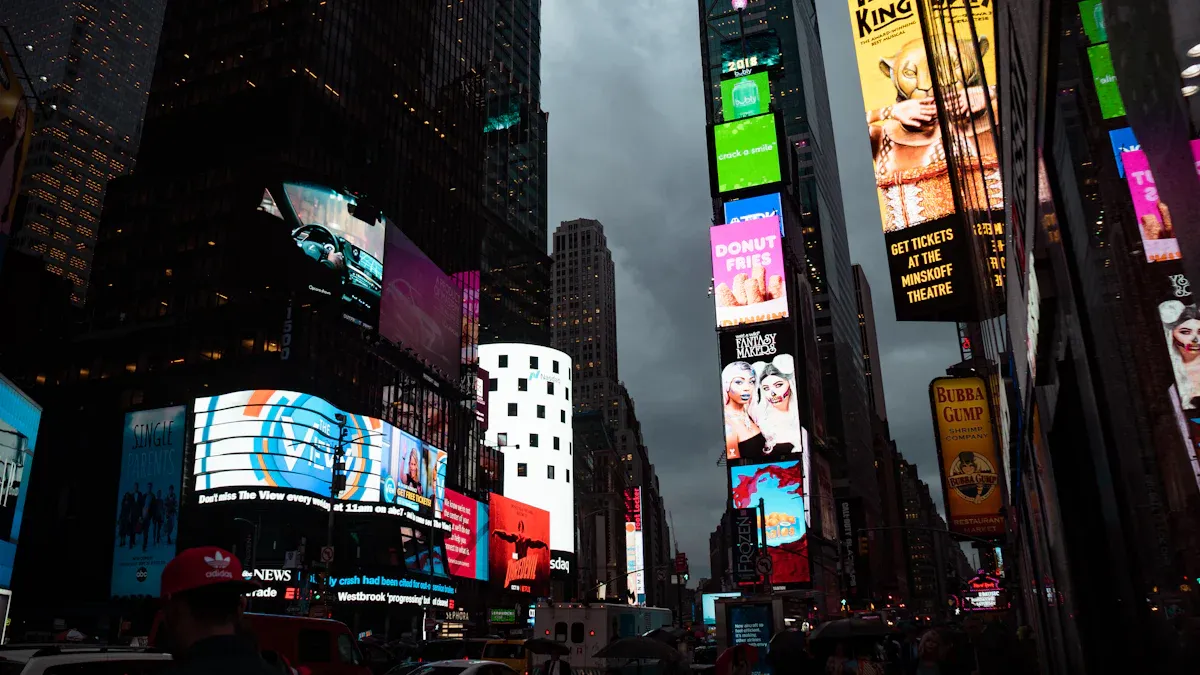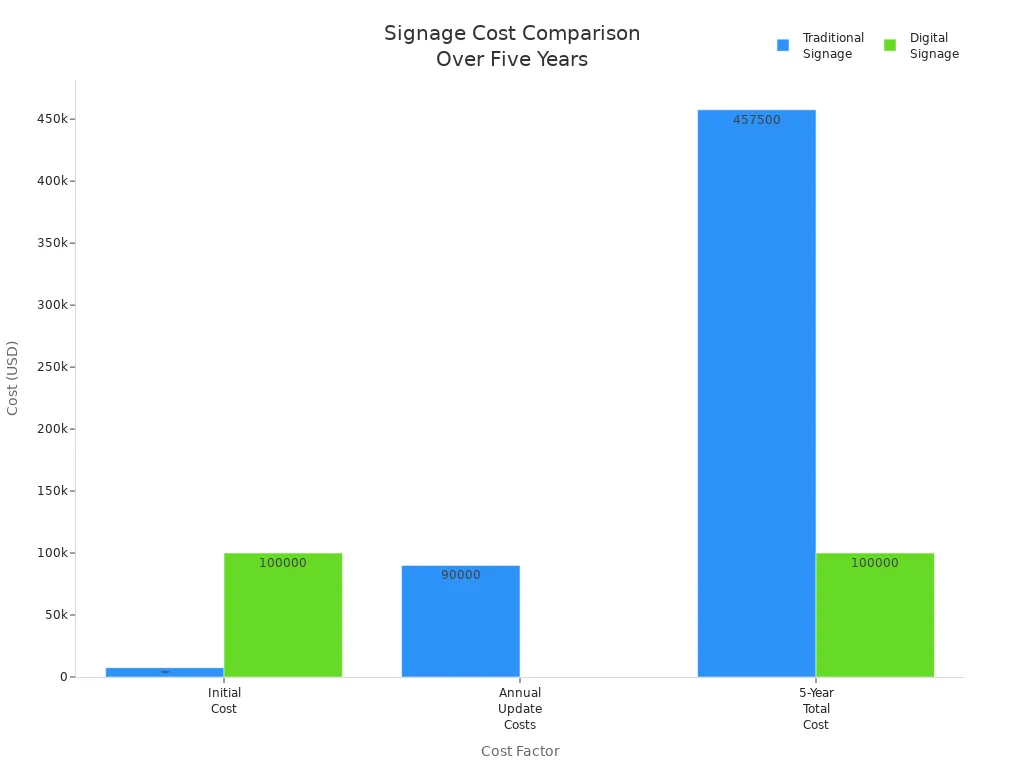
Modern businesses thrive with Announcement & Advertising Display solutions like digital signage. These displays offer more options, capture greater attention, and update quickly. Choosing the right Announcement & Advertising Display helps companies effectively communicate with customers and employees. Studies show digital signage receives 400% more views than traditional signs. Additionally, 68% of people are more likely to purchase products they see on digital screens.
Announcement & Advertising Display technology presents dynamic, interactive content, whereas traditional signage remains static and less adaptable.
Businesses utilize various Announcement & Advertising Displays such as POP displays, banners, and digital screens to boost sales and strengthen their brand.
While traditional signage works well for fixed messages, Announcement & Advertising Displays can be updated rapidly to meet changing business demands.
Key Takeaways
Digital signage gets noticed more and lets businesses change messages fast from any place. Traditional signs are cheaper at first but take more time and money to update later. Digital signs help businesses talk to the right people with videos and things you can touch or use. Using digital signage makes less paper trash but needs careful use of power and recycling. Picking the best sign depends on your business size, how much money you have, and how often you need to change messages.
Overview of Announcement & Advertising Display

Digital Signage Explained
Digital signage uses screens to show information and ads right away. Businesses like digital signs because they can change messages fast. These displays have strong screens, media players, and special software. The software helps plan and play what shows on the screen. Digital signage can show clear pictures, videos, and even let people touch the screen. Companies can control all their digital signs from one place. This makes it simple to keep messages the same everywhere. Remote updates, templates, and network checks help keep the brand strong. These tools also help send the right message to the right people. Digital bulletin boards are a kind of digital signage. Staff can post news or safety alerts quickly. This keeps everyone up to date.
Traditional Signage Defined
Traditional signage means things like posters, banners, billboards, and plaques. Businesses use these signs to show their brand, help people find their way, and share deals. These signs do not change unless someone changes them by hand. Stores use notice boards to show their brand and help shoppers. Restaurants use bright signs to get noticed at night. Print ads, flyers, and mail are still good for some people. Notice boards work well where digital signs are not possible. This can be in the country or places with little power.
Digital Bulletin Boards vs. Traditional Communication Methods
Digital bulletin boards and old ways of sharing news are different. They do not work the same way or get people’s attention the same. The table below shows the main differences:
Aspect | Digital Bulletin Boards | Traditional Notice Boards |
|---|---|---|
Information Delivery | Updates happen fast, can be changed from far away, shows videos and pictures, all screens can match | Must be changed by hand, does not move, you have to be there to see it |
User Interaction | People can touch the screen, get special messages, and companies can see who looks at it | No touching, only put up and read in person |
Visual Impact | Bright screens, moving pictures, grabs attention | Can look messy or old, not as good over time |
Content Management | Uses the cloud, can plan what shows and when, easy to keep neat | Must put up and take down by hand, takes a lot of time |
Environmental Impact | Saves paper, better for the planet | Uses paper, makes more trash |
Reliability | Needs power and internet, can be checked by computer | Works without tech, but cannot change or do new things |
Digital bulletin boards let businesses send news right away and use cool pictures and videos. Old ways, like notice boards, need someone to change them and do not let people interact. Digital signs help companies talk to certain groups with the right message. Traditional signs stay the same and use paper or posters.
Key Differences

Cost and Maintenance
Businesses look at costs when picking digital or traditional signage. Traditional signage needs materials like vinyl, wood, or metal. You also pay for design, printing, and putting up the signs. Sometimes you need permits too. These things can cost a few hundred or even thousands of dollars. The price depends on how big and fancy the sign is. Digital signage costs more at first. You have to buy strong screens, media players, mounts, and special software. Some companies use smart TVs or cheaper options to save money.
Traditional Signage | Digital Signage | |
|---|---|---|
Initial Investment | Materials, design, printing, installation, permits; costs range from hundreds to thousands of dollars | Hardware, software, higher upfront cost, but can use budget options |
Maintenance | Regular cleaning, weather repairs, costly updates requiring reprinting and reinstalling | Lower update and maintenance costs, remote updates, requires electricity and occasional repairs |
Content Flexibility | Static content, changes require physical replacement | Dynamic content, remote updates, multiple content types, time-based messaging |
Digital signage saves money over time. Traditional signs need new prints and must be put up again often. These costs add up fast. Digital signs let you change messages from far away. This saves time and money. The chart below shows how much both types cost over five years for 50 places:

Digital signage costs more at first. But traditional signs cost more each year to update. After five years, digital signage is a better deal. Companies should think about both the costs and the good things each type brings.
Content Flexibility
Digital signage is great because you can change what it shows easily. Digital bulletin boards use special systems to make and show messages from one place. You can update them right away and set times for messages to show. They can also use data from other places. This makes digital signs easy to change. Companies can switch messages fast, show things to certain people, and use videos or moving pictures.
Digital signage lets you update messages right away from anywhere.
You can show different things at different times or places.
Adding more digital signs is simple and quick.
Traditional signs do not change unless you make new ones and put them up. This takes a lot of time and work. It also costs more money. Changing traditional signs can be slow and wasteful. Digital bulletin boards are best for businesses that need to change messages often.
Audience Engagement
Digital signage gets more attention than traditional signs. Digital bulletin boards use bright screens, moving pictures, and things you can touch. Studies say digital signs get four times more views than regular signs. Eight out of ten shoppers go into stores because of digital signs. People remember ads better with digital signs, from 47% to 55%. Stores with digital signs can sell up to 33% more.
Metric/Aspect | Digital Signage | Traditional Announcement Boards |
|---|---|---|
Views Captured | 400% more views than static displays | Passive, easily ignored |
Customer Store Entry Influence | 8 out of 10 customers entered stores due to digital signage | No such influence reported |
Ad Recall | Increases from 47% to 55% with digital signage | Lower recall, passive consumption |
Engagement Style | Dynamic, interactive, multi-sensory, real-time updates | Passive, one-way communication, static content |
Measurement and Analytics | Tracks impressions, dwell time, demographics, sales lift | Difficult to measure effectiveness |
Sales Impact | Boosts sales by up to 31.8% | No comparable sales impact reported |
Digital bulletin boards help companies see who looks at their signs and for how long. They can also see if sales go up. This helps make better messages. Traditional signs cannot do this. They only show messages one way and do not get people involved. Digital signs make people remember messages better.
Studies show people remember up to 83% of what they see on digital signs. Regular signs do not help people remember as much.
Environmental Impact
How signs affect the planet is important too. Digital signage cuts down on paper waste because you do not need to print. Using the cloud means less hardware in stores, which saves energy. Some screens use sleep mode and sensors to save power by up to 30%. Digital signs last five to ten years, so there is less electronic trash.
Digital signage uses LED lights and saves power.
Cloud systems let you control signs from far away, so you travel less.
Recycling programs help deal with old screens and parts.
But digital signs still use more electricity than regular signs. One big digital sign can use more power than four homes. Large LED signs may need extra cooling, which uses even more energy. Some places want rules to stop bright ads at night to save energy.
Traditional signs use paper, vinyl, and plastic. Making these uses trees, water, and energy. Chemicals and dyes can pollute the earth. Changing signs often means more trash, like paper and plastic. Moving and throwing away old signs adds to pollution. Companies that change signs a lot make more waste.
Digital bulletin boards help cut down on paper and support recycling. But companies must be careful with energy use and old electronics.
Choosing the Right Option
Business Size and Needs
How big a business is helps pick the best signage. Big companies often need signs that work in many places. They also need to talk to lots of people at once. These companies like signs they can control from one spot. They also want to send messages to certain groups. Small businesses might like traditional signs because they are simple and cheap. But digital signage can help small businesses too. It is good if they want to show moving pictures or save time. The way an office is set up matters as well. Open rooms are good for big screens everyone can see. If there are many rooms, you may need more screens to cover them all.
Tip: Companies should pick signs that fit their message. Digital displays are best for videos and pictures. Traditional boards are better for lots of words or simple messages.
Update Frequency
How often you change your message matters. Digital signage is great for quick updates. It is best for businesses that change deals or news a lot. This helps keep things running well and keeps people interested. Traditional signs are better for messages that do not change much. Changing these signs takes more time and work.
Feature | Digital Signage | Traditional Signage |
|---|---|---|
Real-time, instant changes | Static, manual replacement |
Budget and Resources
Money is important when picking signs. Digital signage costs more at first. You have to buy screens, software, and pay to set it up. You also pay for software and fixing things later. But over time, you save money because you do not print or change signs by hand. Traditional signs cost less at the start. But you may pay more later to fix or replace them, especially if they are big or outside. If a business does not have much money, it can start with simple digital signs and add more later.
Digital signage saves money by cutting out printing and hand changes.
Traditional signs look cheaper at first but can cost more later for big or outside signs.
Technical Capacity
Using digital signage needs tech skills. Workers must know about screens, media players, and how to use special software. Setting up, fixing, and connecting signs takes know-how. People who make messages need to know design and how to write clearly. Businesses should train workers and plan for help when needed. Traditional signs do not need much tech skill. This makes them easier for teams without computer experts.
Note: Training workers to use digital signage can help things run better and make the most of your money.
Transition Tips for Digital Signage
Planning and Setup
Businesses should first decide what they want from digital signage. Their goals could be to sell more, help workers talk, or share news fast. They must pick the best screen for each spot. Brightness, size, and how tough the screen is are important. Smart TVs or screens with HDMI ports work well. Devices like Google TV or Fire Stick can help too. Companies need to check their internet and power before putting up new screens. A content management system (CMS) lets you change messages from anywhere. Rolling out the screens in steps helps teams get used to them and keeps things running smoothly.
Hardware and Software
A good digital signage system needs strong hardware and smart software. The main hardware is LED or LCD screens, media players, and strong mounts. Outdoor screens need to be bright and safe from weather. Good WiFi or Ethernet helps updates happen fast. The CMS is the main control tool. It lets people change what shows, plan times, and check if screens work. Tools for making content help design cool pictures and videos. Analytics software shows how people use the screens. This helps companies make better choices and get more value.
Staff Training
Staff are very important for digital signage to work well. Training should show how to use the CMS, make content, and plan updates. Short training videos on the screens can help teach new things. Digital signage can also show team goals and deadlines to keep everyone on track. Using different kinds of content and simple animations keeps things fun and new. Regular feedback meetings help staff feel sure of themselves and part of the team. This makes workers more interested and involved.
Measuring Success
It is easier to measure roi with digital signage than with old boards. Businesses can see how long people look at screens and how many see them. Sensors and analytics software collect this data. Companies can test two messages to see which works better. They can track sales, sign-ups, or other actions linked to certain messages. Over time, digital signage gives better data and costs less to update. This makes it a smart pick for many businesses.
Modern businesses use digital signage when they want quick changes and more attention. Digital displays are good for stores and companies with lots of places. Traditional signage is better for businesses with less money or power problems. It also works for simple messages that do not change.
Digital signage lets you update right away and send messages to certain people. It saves money over time. Traditional boards are easy to take care of and always work.
Companies should pick the type that fits their goals, how often they need to update, and what they have to work with. This helps them get the best results.
FAQ
What is the main benefit of digital signage for businesses?
Digital signage helps businesses change messages fast. They can show videos, pictures, and news right away. This makes people notice and keeps info new.
Can small businesses use digital signage?
Small businesses can use digital signage too. They might begin with one screen and add more later. It saves time and money because they do not need to print.
How long does traditional signage last?
Traditional signage lasts a few years if it stays inside. Outdoor signs can fade or break sooner. Sun and rain can make them wear out faster.
Does digital signage need the internet to work?
Most digital signage needs the internet to update and control from far away. Some can show saved things without being online. The internet helps keep messages up to date.
Is digital signage better for the environment?
Digital signage cuts down on paper and printing. It uses power, so screens that save energy are good. Recycling old screens and using less power helps the planet.
See Also
Audi Tesla-Inspired CarPlay Screens Compared By Features And Cost
Comparing Wireless CarPlay Adapters And AI Boxes For Best Value
Best CarPlay To HDMI Dongles For 4K Streaming In 2025
